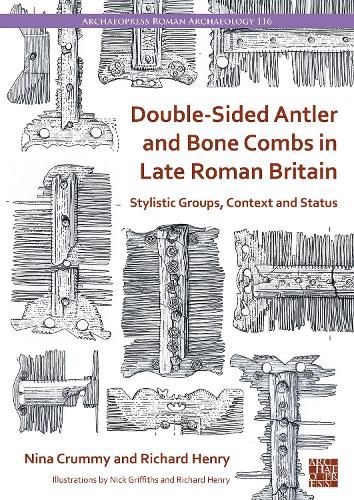Readings Newsletter
Become a Readings Member to make your shopping experience even easier.
Sign in or sign up for free!
You’re not far away from qualifying for FREE standard shipping within Australia
You’ve qualified for FREE standard shipping within Australia
The cart is loading…






Double-Sided Antler and Bone Combs in Late Roman Britain offers the first detailed study and catalogue of a comb type that represents a new technology introduced into Britain towards the end of the 4th century AD and a major signifier of the late fourth- to fifth-century transition. Their end-plates were worked into a variety of decorative profiles, some clearly zoomorphic. Over time this decorative styling passed from elaborate to rudimentary, adding to the dating evidence for individual combs. As many combs survive only as small fragments, data collection has not been absolute but has concentrated on combs from burials, or with stylistically relevant end-plates, or those providing good dating or contextual evidence, the main aim of the study being to answer questions of typology, chronology and social distribution. A particularly distinctive feature within the assemblage from funerary contexts is the substantial number of these combs from Winchester, which together make up nearly a quarter of the wider British assemblage. It is proposed that a comb workshop was established in the town, and there is some evidence based on style and distribution that points to other workshops in the north and east, but these were not necessarily large and in some cases they appeared to serve only a local community, while Winchester and its hinterland appear to lie at the heart of the comb data.
$9.00 standard shipping within Australia
FREE standard shipping within Australia for orders over $100.00
Express & International shipping calculated at checkout
Double-Sided Antler and Bone Combs in Late Roman Britain offers the first detailed study and catalogue of a comb type that represents a new technology introduced into Britain towards the end of the 4th century AD and a major signifier of the late fourth- to fifth-century transition. Their end-plates were worked into a variety of decorative profiles, some clearly zoomorphic. Over time this decorative styling passed from elaborate to rudimentary, adding to the dating evidence for individual combs. As many combs survive only as small fragments, data collection has not been absolute but has concentrated on combs from burials, or with stylistically relevant end-plates, or those providing good dating or contextual evidence, the main aim of the study being to answer questions of typology, chronology and social distribution. A particularly distinctive feature within the assemblage from funerary contexts is the substantial number of these combs from Winchester, which together make up nearly a quarter of the wider British assemblage. It is proposed that a comb workshop was established in the town, and there is some evidence based on style and distribution that points to other workshops in the north and east, but these were not necessarily large and in some cases they appeared to serve only a local community, while Winchester and its hinterland appear to lie at the heart of the comb data.